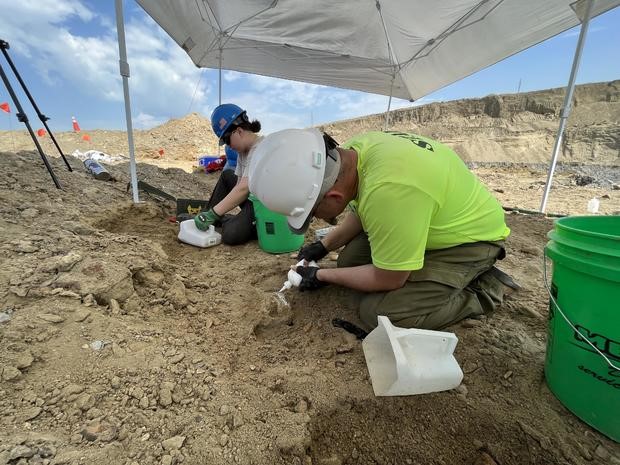U.S. Coal miners lead paleontologists to partial mammoth fossil in North Dakota
Posted 12/19/23 (Tue)
BY ALIZA CHASAN
A team in North Dakota uncovered more than 20 bones from a mammoth skeleton after coal miners found a well-preserved, 7-foot-long tusk, the North Dakota Geological Survey said Monday.
Miners at the Freedom Mine first discovered the tusk over Memorial Day weekend. They roped off the site until representatives from the North Dakota Geological Survey, the State Historical Society of North Dakota and the Bureau of Land Management arrived. A team of paleontologists from the North Dakota Geological Survey later spent 12 days excavating an old streambed, the North Dakota Geological Survey said in a press release.
"Most of the mammoth fossils known from North Dakota are isolated bones and teeth," Clint Boyd, North Dakota Geological Survey senior paleontologist, said. "This specimen is one of the most complete mammoth skeletons discovered in North Dakota, making it an exciting and scientifically important discovery."
The paleontologists found ribs, a shoulder blade, a tooth and parts of the hips, according to the release. The bones were stabilized in protective plaster jackets and taken to the North Dakota Heritage Center & State Museum paleontology lab in Bismarck, where they'll be meticulously cleaned and stabilized.
State officials are also working to determine where the remains can be put on display so that "as many people as possible can see this specimen and learn what it tells us about life in North Dakota during the Ice Age," the release said.
Several types of mammoths lived in North Dakota during the Ice Age, including the woolly mammoth and the Columbian mammoth. Paleontologists will determine which type of mammoth bones were found after the remains have been fully cleaned.
Mammoths went extinct at the end of the Ice Age about 10,000 years ago. Wooly mammoths are more closely related to the modern African elephant than to the Asian elephant, according to the National Park Service. Columbian mammoths, however, are more closely related to Asian elephants. Males and females of both species had long, curved tusks.

Paleontologists Clint Boyd (white helmet) and Abigail Glass (blue helmet) excavate sediment from the ancient stream channel that preserved the mammoth bones.